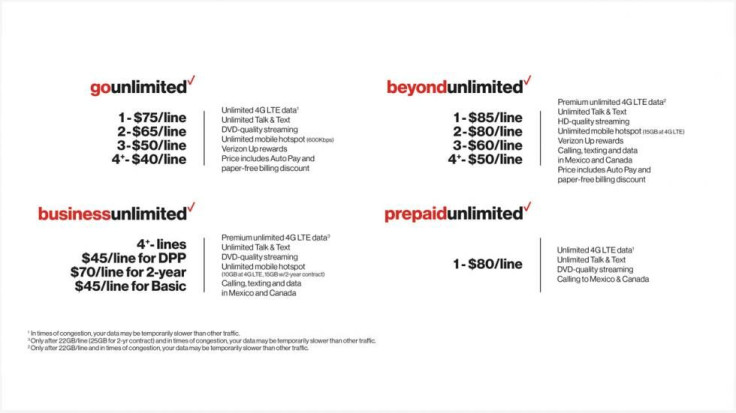Net Neutrality: Verizon Caps Streaming Video On New Unlimited Data Plans

Verizon has updated its unlimited data packages for mobile subscribers and users who want to stream video will now be subject to data throttling.
Beginning Wednesday, Verizon will now split its unlimited data offerings into three separate tiers that will all feature capped streaming video quality: Via Verizon, here’s what subscribers can now expect:

Notably, the basic Go Unlimited plan will feature “DVD-quality streaming,” which translates to standard definition video at a resolution of 480p. The plan also includes a new throttling for mobile hotspot users that caps browsing speeds at a paltry 600Kbps.
The Beyond Unlimited plan features a $5 monthly price bump on Verizon’s current plans and includes 720p video streaming, unthrottled (but capped) mobile streaming and full mobile coverage within North America. On tablets with cellular data support, users will be able to stream video in full 1080p.
Current Verizon subscribers on legacy plans will also be subject to these new video streaming caps. Right now, Verizon offers a single unlimited data package that starts at $80 per line. The unlimited portion of its plan also comes with a caveat, as it’ll start to throttle performance for users who use more than 22GB of data per month.
Verizon’s updated data plans for customers comes weeks after the carrier’s streaming policies came under scrutiny. Last month, users on social media found that Verizon had been capping their video streaming rates on all apps to around 10 Mbps, which is significantly below what the carrier’s LTE network can typically provide. At the time, Verizon pinned the issue on “network testing” that was done on a limited basis.
Verizon will also be the latest carrier to implement hard caps on video streaming performance. AT&T and T-Mobile features similar caps for its various packages that cap streaming performance on basic plans to 480p. While Sprint features full HD streaming for video, the carrier also has separate data caps for categories like games and streaming music.
For most users, Verizon’s move to split up its video streaming abilities into tiers comes with some qualifiers. At the moment, few phones feature displays that could stream at a 4K resolution, which would require higher-end download speeds. For services like Netflix, they typically need download speeds of at least 5 Mbps to stream in high-definition. As Verizon claimed in a statement announcing the update, most users won’t notice a difference in visual quality on video that’s streamed at more than 720p on a smartphone or 1080p on a tablet.
However, Verizon’s move has been a concern among net neutrality supporters, who contend that the carrier’s streaming throttling and divvying up of its service options for consumers reflects what could become increasingly commonplace if the policy is reversed. Current Federal Communications Commission chairman Ajit Pai has been a well-documented opponent of net neutrality and has made reversing policies from previous chairperson Tom Wheeler a major focus during his appointment.
For its part, Verizon denies that it’s violating existing net neutrality policies. In a statement, the company told Ars Technica that current policies allow carriers to manage traffic to ensure smooth performance and that video performance caps are a “non-discriminatory network management practice” that guarantees consistent network speeds. By implementing a blanket streaming limitation policy, the carrier is also likely safe from net neutrality claims that it could be implementing preferential treatment of one service over another.
© Copyright IBTimes 2025. All rights reserved.




















